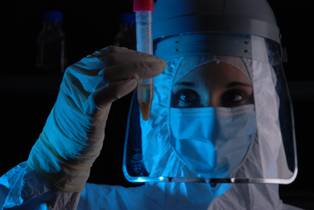18th century Irish giant helps find genetic cause of acromegaly
7 Jan 2011
An Anglo-German research team has analysed the genes of the Irish Giant skeleton held in the Hunterian Museum in London to help identify the genetic mutation responsible for acromegaly.
It is hoped that the discovery will help in the treatment of patients suffering from acromegaly, which is also called gigantism.
Gigantism is known to be caused by a tumour of the pituitary gland, a gland located at the base of the brain from where it releases hormones that regulate several functions of the body — one being growth.
Pituitary tumours can cause tissues to grow abnormally resulting in certain changes in facial appearance, enlarged hands and feet, headache and sweating — eyesight too can be affected; this condition is called acromegaly.
Márta Korbonits, Professor of Endocrinology and Metabolism at Barts and the London School of Medicine and Dentistry, initially looked at the aryl hydrocarbon receptor interacting protein (AIP) gene.
It has been known since 2006 that defects to this gene are associated with a predisposition to development of pituitary tumours, and Professor Korbonits was able to identify a specific genetic mutation in Irish patients with a family history of acromegaly.
Leading international paleogenetics experts Professor Dr Joachim Burger and Martina Unterländer of the Institute of Anthropology at Johannes Gutenberg University Mainz, Germany, subsequently extracted and analyzed the DNA from the skeleton of an 18th-century acromegaly patient preserved in the Hunterian Museum in London.

Analysis of old DNA at JGU labs. Photo credit:
Joachim Burger.
The research team discovered exactly the same mutation as the one found in living patients. Further analyses of other DNA segments located in the vicinity of this gene led to the conclusion that the Hunterian Museum's so-called "Irish Giant" had inherited the mutation from a common ancestor that he shared with a number of living Irish families who are suffering from this hereditary disorder today.
The subsequent complex biostatistical calculations showed that the original mutation developed around 1,500 years ago and has been passed on from generation to generation ever since. It is estimated that around 200 to 300 people still carry the mutation today.
"The ancient DNA from the skeleton has enabled us to confirm the hypothesis that there is indeed a link between the mutation and this disease, a disorder which in the past so often resulted in tragedy," explains Professor Joachim Burger from Mainz University. "The biomathematical calculations have even provided us with a highly accurate insight into the history of this illness."
Márta Korbonits, head of the study, adds: "The most important clinical aspect of our study is that it is now possible to trace down carriers of this gene in time and treat patients before they grow to be a giant."
Professor Patrick Morrison, co-author of the study, concludes: "He benefits to patients locally are that we now have a genetic blood test that families at risk of this condition can choose to have, which allows early detection and prevention of excessive growth."
Reference
1. Chahal, HS, et al. AIP Mutation in an 18th Century Giant and Contemporary Families with Pituitary Adenomas. The New England Journal of Medicine 2011; 364:43-50 (6 Jan. 2011).